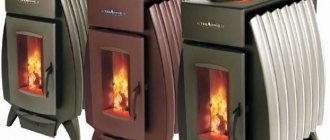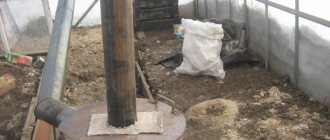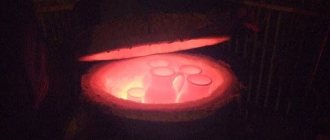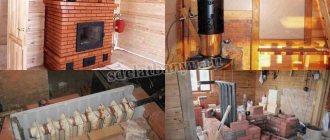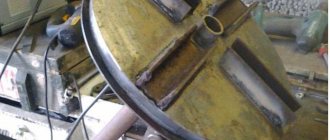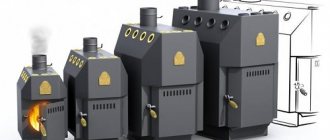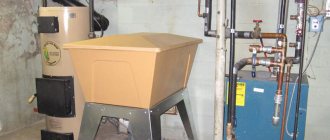Not every owner of a country house or country house has the opportunity to install a heating system running on natural gas on their property. Such a nuisance may arise due to the high cost of connecting to the main line or the lack of a centralized supply. The solution to this problem can be a miracle wood-burning stove. It can be heated with any solid fuel, such as wood or coal.
The miracle stove can be heated with any solid fuel, this is convenient if there is no access to natural gas or electricity
What are the benefits of autonomous long-burning heat generators?
Why are autonomous stoves more profitable than centralized heating? The fact is that powerful industrial heating boilers with 100% efficiency lose up to 30% of heat when passing through main and distribution pipelines. Autonomous heating operates without heat loss, and its performance is determined by the efficiency of the boiler used for heating. Homemade stoves may be unsightly in appearance, but have an efficiency of more than 90%. They can be heated with wood, coal and waste.
An efficient and economical wood-burning pyrolysis boiler retains heat for a long time
How does pyrolysis proceed?
The pyrolysis process goes through four stages:
- Drying – excess moisture is removed from the firewood. It is performed during the preparation process or in the firebox due to its heat.
- Pyrolysis is the sublimation of volatile components, the decomposition of heavy components - resins and bitumen to volatiles. The fuel mass begins to carbonize, that is, char.
- Combustion of pyrolysis gases upon reaching the flash point under the influence of high temperature and free oxygen. Carbon combustion begins when the temperature rises above 600 degrees.
- After the combustion of volatile components and the bulk of carbon, reduction reactions begin - the release of carbon monoxide, free hydrogen and oxygen.
In order for the efficiency to be high, when designing the equipment, it is necessary to ensure that the reducing gases are retained in the hot zone and access of heated fresh air is ensured there. With rapid cooling, the energy spent on recovery will fly out into the chimney. Don't forget that carbon monoxide is poisonous.
Note: One of the main advantages of a slow burning stove is its ease of operation. Firewood is loaded into it once or twice a day, and ash is raked out once or twice a week.
Solid fuel stove potbelly stove
Outside cities, firewood is the most affordable, so the most popular long-burning stove is a wood-burning stove. They heat it not only with firewood from the ridge, but also with waste wood - shavings, sawdust, waste fiberboard and chipboard, small brushwood, straw, etc. There are many heating systems using wood and wood waste. Let's consider the most efficient ones, the efficiency of which is more than 70%.
You can make the simplest potbelly stove with your own hands
A potbelly stove is an economical stove that appeared in Russia after the revolution, during the times of military communism, when many had to endure hardships. The genius of the potbelly stove is that it warms up instantly, as well as the simplicity of its design, the prototype of which was the Russian stove. The upper door is for storing firewood, the lower one is for regulating combustion by supplying air through the slightly open door.
The purpose of a potbelly stove: to keep at least one room warm at minimal cost. When using coal, the grate is removed, and air from the ash pit is directed into the firebox. It is important not to overcrowd it - the volume of the bookmark should be no more than a quarter of its volume. The afterburning chamber is a long horizontal or slightly inclined part of the chimney. Made of metal, it retains heat in the room.
Important! The potbelly stove can operate on all types of solid fuel, except sawdust. It is made in the form of a box made of sheet steel or a round one made of a barrel. Chimney diameter – 85 – 150 mm.
Such a potbelly stove will not only warm you up, but also decorate your interior.
When fired, any potbelly stove becomes red-hot, so its upper surface can be used as a cooking surface. A screen should be installed on the sides at a distance of 40-60 mm from the stove. It protects the room from IR rays and maintains the temperature at an optimal level.
Using a potbelly stove, you can make a homemade long-burning wood-burning boiler. To do this, instead of a screen, a U-shaped metal water heater is installed. The distance between the furnace body and the boiler should be the same as the screen indentation.
The first method or boiler No. 1
The natural vortex is replaced by forced pressurization, and pyrolysis is divided into two stages in space: a pyrolysis chamber, a nozzle (nozzle) that forms a flow of pyrolysis gases, and a combustion chamber. The nozzle is made so that there are no parasitic turbulence behind the mass of fuel. To ensure complete control over the process, through blowing is necessary.
Features of direct-flow and heat-storing pyrolysis boilers:
Note: the rate of pyrolysis and the composition of gases is affected by the type of fuel. These factors are taken into account by regulating the back pressure at the outlet by throttling the chimney. Regulators for industrial solid fuel boilers are equipped with marks indicating the recommended type of fuel.
The efficiency of once-through boilers can be above 90%. They require power to operate. When switching off, to further start the system, it is necessary to remove the sintered mass and make a new filling in the firebox.
Steam-assisted solid fuel boilers use different types of fuel
The second method or boiler No. 2
A pyrolysis boiler with a water heater, which does not require electricity or automation, works on the principle of counteracting the two laws of the square-cube. This refers to the laying of fuel and lining of fireclay bricks. Algorithm for the operation of a brick kiln:
Loading firewood or coal into a boiler with a heat buffer is done gradually. Sharp temperature fluctuations are contraindicated for her. If too sluggish fuel is used, it may stall. If it is too flammable, there is a risk of an emergency. If the first heat is not suppressed, the efficiency will not exceed 76-78%, since instantaneous heat transfer from the lining to the outside is excluded.
Ignition
You should start igniting outside, and when it has already flared up, bring it indoors to avoid unpleasant odors. If the device is not used for a long time, you should first clean it thoroughly.
Important! The device must be installed horizontally and levelly to achieve uniform combustion of the wick.
Ignition step by step guide:
- The principle of operation of a diesel fuel heater
Fill the removable tank with diesel fuel.
- Install a new filter into the burner.
- Replace the burner, as well as the removable tank.
- Unscrew the valve to allow fuel to flow to the wick.
- Open the front door and light a heating pad from underneath.
- As soon as the fuel ignites and the flame is above the grate, the valve should be fully tightened.
- When the fire begins to die down, open the valve and set it to the desired intensity.
To turn off the device, simply close the valve completely.
If you can't get an even blue flame across the entire wick, you may have one of the following problems:
- the device is installed on an uneven surface;
- the burner cylinder did not have time to warm up;
- The wick is worn out.
Advice! To extend the life of the wick, it should be washed in kerosene from time to time. In addition, you can turn it over or cut off the burnt edge.
English fireplace
There are legends about the attractiveness of fire; its decorative and aesthetic function is of great importance for humans. Can an ordinary person build a long-burning fireplace in his home to enjoy not only the warmth, but also the beauty of fire? The main thing in such devices is not heat transfer and efficiency, but the ability to contemplate the fire during the day.
A fireplace in the English style, made with your own hands, will decorate your interior
There are such designs, and they were invented by the British. A classic English fireplace has a smoke tooth, reminiscent of a threshold in a Russian stove, which forms a circulation of flue gases that does not allow fresh air to rise, directing it into the filling, as happens in a potbelly stove.
Due to the large mouth, the efficiency of the fireplace is small - no more than 50%, even if there are smoke circulations in the chimney. Smoldering and heat generation from evening to morning occurs only when using Cornish coal or similar coking coal. They say that in the old days English lords lit their fireplaces with the rhizomes of pine trees growing on the coastal cliffs.
An example of another “long” fireplace is an ordinary Dutch fireplace. Before kindling, the ash pit is closed, firewood is loaded onto a quarter of the firebox, its door remains wide open. The main part of the heat flies into the pipe, but the decorative effect is ensured.
Types of devices
The traditional Russian stove does not fit into the design of modern buildings, it takes up too much space, and its heating capabilities leave much to be desired. Nowadays, it is not advisable to install a bulky stove, because you can build a more compact and efficient device if you find suitable drawings. Assembling a miracle oven with your own hands is not as difficult as it might seem at first glance. Such a device can make a room warm and cozy even on the coldest days. Miracle wood-burning stoves come in the following types:
- potbelly stoves;
- devices under testing;
- buleryans or bullers.
If the owner of the house knows how to work with his hands, then with the help of schematic descriptions and video master classes he will be able to create the device he likes. This will help him acquire a heating system without constructing a pipeline and installing radiators.
You can see an example of a wood-burning miracle stove in this video:
Metal potbelly stove
Such installations are usually used in small rooms, for example, in garages, sheds, greenhouses and country houses with a small area. They are great for creating a warm microclimate and are an ordinary barrel with thick metal walls. Before its manufacture, a drawing is developed, according to which the unit is subsequently assembled.
The design of the Buleryan stove assumes self-assembly
The body must have a volume of at least 100 liters; its internal space is divided into two parts by placing a metal partition 5-10 millimeters thick there. A hole is made in it to be able to clean the device from combustion products. The first compartment plays the role of a combustion chamber, and the second is designed to collect ash.
An iron box is placed in the ash pan, in which all the garbage will accumulate. A hole for the combustion chamber is cut out in the front wall; its size is usually 40x40 centimeters. The ash pan also needs an opening, but it is smaller than the first by about 10-15 centimeters. It must be equipped with a valve and a door.
The barrel itself is closed with a lid through which a chimney pipe is inserted into the stove. All parts of the furnace are connected together using a welding machine. The finished structure is placed on legs or a brick stand so that when it is hot it does not damage or set fire to the floor. It is worth noting that such a device has disadvantages:
- cools down quickly;
- you need to regularly add firewood to it;
- low efficiency.
However, the potbelly stove has a low cost and is very easy to assemble. Typically, craftsmen spend no more than 3 hours on making a structure. It is capable of heating small rooms, which is why such devices are often placed in bathhouses.
Buleryan or buller
A powerful air heater suitable for heating various areas is a buleryan (otherwise known as a buller). The price of such a stove is several times higher than that of a potbelly stove; in addition, not every owner can cope with its assembly. The device has a more complex design, and its manufacture requires detailed drawings, as well as the ability to perform plumbing and welding work.
The complex structure of a wood-burning stove requires detailed drawings
A distinctive feature of such stoves is the ability to regulate the burning time of wood. One load of fuel can provide an average room with heat for 10-12 hours. In addition, the heat comes not only from the device itself, but also from the pipes. They must be included in the design of such a furnace.
It is not necessary to use iron to make a buller. The structure can be made of brick. A large body will increase the power of the stove, and the chimney is easily made from cement pipes.
However, such a device has a serious drawback - uneven heating of the air. The temperature of the floor is much lower than that of the ceiling. This disadvantage can be compensated for by connecting water heating pipes to the device. In this case, the stove will not only warm up the entire room completely, but will also provide the household with hot water.
It is worth noting that while the buleryan is operating, the room warms up not only due to the heat generated by the body, but also from the hot air coming out of the stove. The process looks like this:
- The firewood gradually burns out.
- The heated air flow passes into a special chamber.
- There it gives off some of the heat to the walls and then goes outside.
The advantage of such an installation is its ability to burn the gases released by the fuel during combustion. This significantly increases efficiency and the amount of heat generated. It is for these purposes that the stove is divided into two compartments: in the first, wood burns, and in the second, gas. This happens using a special arrangement of nozzles. This feature allows you to save fuel and also eliminates the formation of ash and soot, which makes cleaning the stove more convenient and quick.
Thanks to the special design, the amount of fuel is reduced and heat transfer is increased
It is important to place the chimney closer to the floor. To better understand the design and mechanism of operation of the buleryan, it is recommended to watch several videos on this topic. Information is never superfluous, and the master will be able to obtain more accurate and visual information that will help him create a detailed and accurate drawing of his own device.
Stoves under development
It is better not to use such devices for heating residential buildings, since burning oil smells unpleasant and also releases carcinogenic substances into the air that are hazardous to health. Car enthusiasts should pay attention to such devices, because they can be placed in garages. They have a rather simple and primitive design, so these stoves are easy to make yourself.
Exhaust devices warm up the air quickly, but have a number of disadvantages: they require constant monitoring, systematic addition of firewood, and are characterized by low productivity.
The simplest DIY stove
Long-burning solid fuel boilers, which were mentioned above, are difficult to make with your own hands according to the scheme. The drawings below will help the DIYer build a simple heating device on his own. Equipment power – 35 kW, efficiency – up to 85%, combustion duration – 12 hours. Coal or fuel pellets are used as fuel. Loading with wood reduces efficiency to 75%, burning duration is reduced to 8-10 hours.
A drawing of the design of the stove will help you make it yourself
The lineup
Today there are many models of the Butakov stove on the market. Below we will consider the main ones.
- The Gymnasist device, with a power of only 7 kW, is capable of heating up to 100 m² of area. The height of the chimney is 5 m.
- The Student stove (9 kW) can heat a room up to 150 m². The maximum fuel volume is up to 20 kg. The height of the chimney is 5 m.
- Professor Butakov’s “Engineer” unit (15 kW) will heat a room up to 250 m². The maximum fuel volume is 40 kg. The height of the chimney is 5 m.
- The Docent stove (25 kW) will heat a home up to 500 m². The design can hold up to 100 kg of flammable substances. The height of the chimney is 6 m.
- The “Professor” device (40 kW) is capable of heating up to 1000 m² of housing. The maximum fuel volume is 200 kg. The height of the chimney is 8 m.
- The Akademik unit (55 kW) can warm up a house with an area of up to 1200 m². The stove can hold up to 240 kg of flammable material.
Each model has its own dimensions. The larger the fuel space and firebox, the larger the dimensions of the stove.
The optimal choice of device depends on its purpose and the area of the premises requiring heating.
The compact stove “Gimnasist” can heat up to 100 square meters. meters. Its chimney goes up, so this unit is suitable for country houses and garage buildings. For other models, the chimney exits to the top or is located at the rear of the structure. They are mainly installed in large rooms.
Scheme and possibility of design improvement
Slobozhanka is a full-fledged miracle wood-burning oven with a hob. Air is supplied to the smoldering material from the side along a U-shaped path: down the L-shaped air duct and then through the perforated casing. Access is provided to all layers, which promotes more active pyrolysis, so Slobozhanka works well on coal and pellets. This is an economical device with an efficiency of more than 80%.
The power of the equipment can be increased by complicating its design: stretching the internal perforated casing over the entire circumference. To equip the blower with a throttle, a third narrow casing is made to cover the air intakes from the outside.
Vertical Slobozhanka is made on the basis of a barrel
Diesel stoves
Today, a diesel stove is considered an excellent option for heating a small summer house.
It requires diesel fuel or diesel fuel to operate. Such a stove is considered kerogas in its essence. Only its design and appearance have been modernized.
In addition to summer houses, this device can be used to heat: a room for industrial needs, a kiosk and other small buildings.
This device also allows you to prepare food or boil water on it.
It can be fueled by either diesel fuel or kerosene. The weight and size of such a diesel stove are modest. Thanks to this, she is often taken fishing, hunting or hiking.
Diesel stoves have differences in:
- heat power,
- burner or flask material,
- indicators and form.
Slobozhanka with a mushroom hat
The traditional Slobozhanka has disadvantages:
- It does not accept fatty and tarry fuels. Household waste, chipboard and fiberboard waste form hard deposits on the edges of the holes in the internal casing and the perforated casing of the air duct.
- Careful refueling of the unsmoldered filling is required, since at least a small smoldering area should remain free near the perforation of the casing. If this is not provided for, after the filling burns out, the stove will cool down.
The design with a central conical perforated air duct with a mushroom cap is the development of one of the Soviet mailboxes. Created on the basis of Slobozhanka. The cone was freely installed in the discharge hatch of the firebox and removed for cleaning.
The edges of the cap threw fuel to the edges, and a smoldering ring was formed under it, necessary for lighting the stove. Additional loading could be made in any quantity and at any time. Due to the edges of the hat, air was directed to the smoldering zone, which ensured the omnivorous design.
The disadvantage of the “slobozhanka with fungus” was that when burning household waste or damp pine it was necessary to check the soot. The cone could have become stuck tightly. In this case it was difficult to remove it without distorting it.
Miracle diesel stove
A small diesel stove has low fuel consumption. For example, if the heating capacity is 2.5 kW, then only 0.2 liters of diesel will be consumed per hour. The design itself is small in size, with certain models weighing 10 kg or less. The design is incredibly simple, it consists of:
- metal case;
- open tank;
- fuel tank.
To ensure that fuel does not leak out of the tank regularly, the outlet section of the pipe has a specialized valve. The most common burner does not stop working due to fuel and has the form of a wick, the part at the bottom of which is immersed in a tank with fuel. When the valve opens, fuel is supplied to the working container, the wick begins to absorb fuel. After a certain period of time, the diesel stove ignites, heats up and begins to operate as usual.
Very often, manufacturers place a grate over the burner so that, if necessary, the client has the opportunity to heat water in a bucket or pan. As an example of this equipment, you can consider “Solyarogaz PO-1.8”. This stove model has a power of 1.8 kW and is produced in Russia. Such a diesel stove must be used according to specific rules. For example, in order to remove the pungent aroma, ignition must be done outside.
It is advisable not to use this equipment on an ongoing basis, because in this case you will also encounter a pungent odor. But active work is still possible; for this it will be necessary to change the wick and clean the burner.
